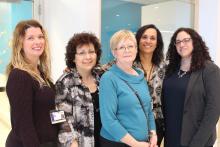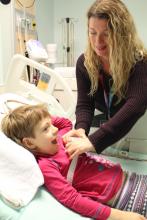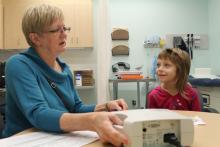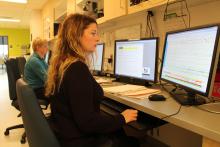A day (and night) in the life of a…respiratory therapist in the Sleep Lab!
The Montreal Children’s Hospital’s Sleep Laboratory (Sleep Lab) first opened its doors in 1990. They were initially set up in an office space that was converted into a sleep laboratory and only saw one overnight patient a month. Fast-forward 27 years and the Sleep Lab has grown tremendously, both in patient volume and physical space.
And, respiratory therapist Sylvia Ladan has been there to see it all.
Activities during the day
The Pediatric Sleep Lab is divided into day and night activities. Sylvia works alongside Diana Zinno, Assistant Chief of the Sleep and Pulmonary Function Laboratory for Pediatric Respiratory Services, as well as respiratory therapists, Angie Penta, Isabelle Blanchette, Georgia Kotsirilos, and administrative agent Marisa Campellone. They triage referrals and work with pediatric sleep specialists, Dr. Robert Brouillette and Director of the Pediatric Sleep Laboratory, Dr. Evelyn Constantin. During the daytime, they assess patients who have been referred for suspected obstructive sleep apnea or other sleep disorders. Patients are sent home with an oximeter, a small portable medical device that measures the oxygen level in their blood and heart rate while they sleep. It helps the team rule out obstructive sleep apnea or other breathing issues during sleep.
“We teach parents how to set up the machine at home by placing a probe on their child’s toe,” says Sylvia. “We use oximetry as a screening test to determine if the patient has abnormal oxygen levels and to see if the patient needs to come to the hospital’s Sleep Lab for a more detailed overnight sleep study.” The Sleep Lab can send out up to six machines a day, but the waiting list remains long as there is a high demand for this type of sleep assessment. In some instances, the team also sends patients home with an Actiwatch, an activity monitor similar to a Fitbit. The machine is worn on the wrist and measures light and activity to determine a child’s sleep/wake pattern. “We see a variety of children with different sleep disorders, including obstructive and central sleep apnea, night terrors, sleep walking, restless leg syndrome and narcolepsy,” explains Sylvia. “Our patients also range in age from newborns to teenagers.”
Diagnosing sleep disorders overnight
In more serious cases, a patient will be asked to come in for an overnight sleep study in the Sleep Lab. The overnight study is called a Polysomnography test, and is used to diagnose sleep disorders. It measures a child’s brain waves and eye movements, oxygen and carbon dioxide levels, heart rate and breathing, as well as leg movements during sleep. Each study can last between eight to nine hours, and the Sleep Lab can run up to two overnight studies three nights a week. The child’s parent sleeps alongside them in a cot, but the child is observed constantly by a night shift respiratory therapist close-by in the monitoring room.
“Our patients usually arrive around 6:30 p.m. and then the respiratory therapist will begin putting the electrodes on,” says Sylvia, who up until recently was working the overnight shift. Over 25 sensors are attached to the patient from head to toe. They attach two respiratory bands across the chest and abdomen to monitor breathing, 13 EEG sensors on the head and face, as well as a snore sensor on the neck to monitor vibrations and a nasal flow sensor.
While the patient sleeps, respiratory therapists analyze all the data in real time. They look at the child’s sleep state, desaturation levels, respiratory patterns, carbon dioxide differences, and muscle activities. “We evaluate and analyze all of these channels every 30 seconds and then we come back the following day to look at the data more closely and score,” explains Sylvia. Scoring is a quantitative analysis of the data to help evaluate the severity of the sleep disorder. A nine hour recording contains over a thousand segments of data and all of it needs to be scored. This can take up to four hours of analysis per patient. Once the respiratory therapist scores the study, the sleep medicine doctor then interprets the polysomnography and provides a diagnosis and recommendations. “Infant scoring is different than pediatric scoring and sometimes more difficult to interpret,” says Sylvia. “The various sleep stages are very different in newborns compared to older children.”
Sylvia says that respiratory therapists who work in the Sleep Lab develop a unique skill for setting up the patients so that they feel comfortable enough to actually fall asleep. “We put on the sensors while the child is awake, but it can be very difficult in certain situations, especially with younger patients who require more attention,” she says. Some patients come in with existing equipment, like continuous positive airway pressure (CPAP) machines, and the settings of these machines have to be fine-tuned by the respiratory therapist during the night. “We have to be great multi-taskers and technically-savvy,” says Sylvia, who in addition to her Respiratory Therapy degree also acquired extra certification as a Registered Polysomnography Technician. “It’s definitely something you learn on the job and become very good at. We always have one eye on the patient and one eye on the data.” And if the patient is struggling too much to breathe or requires immediate treatment, the physician on-call and the respiratory therapist will arrange for the patient to be sent to the Emergency department or admitted to the hospital for further observation and treatment.
“Watching a child struggle to breathe while sleeping is a difficult thing to witness,” she says. “Sleep has such an effect on a person’s quality of life and behaviour and it’s so rewarding when a patient’s sleep disorder is resolved and they can finally have a good night rest. It really changes their entire life.”






